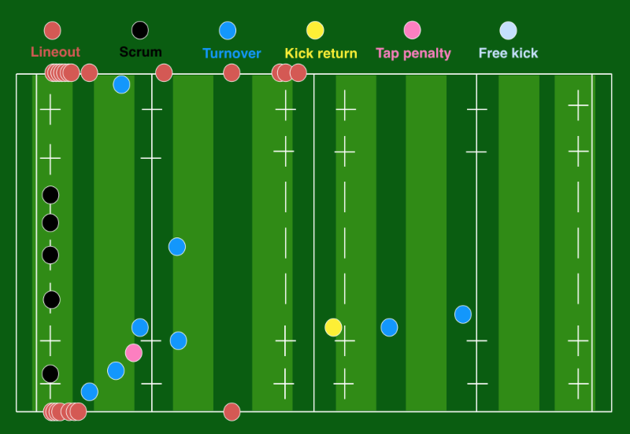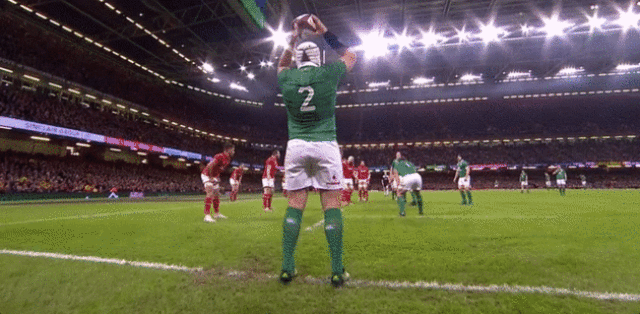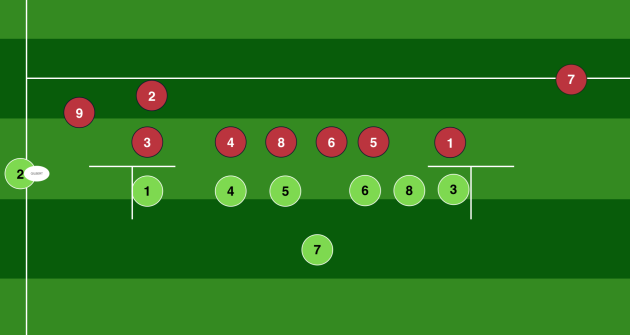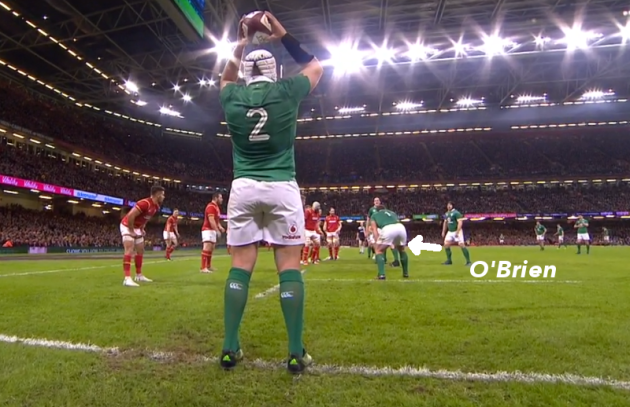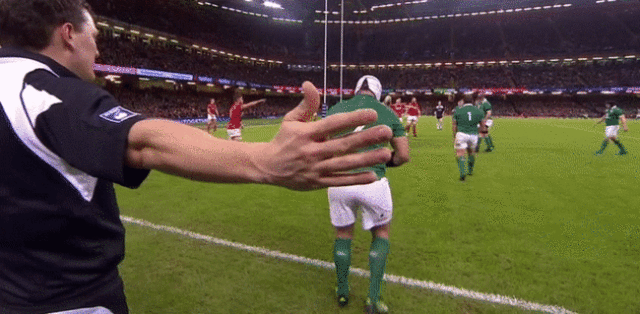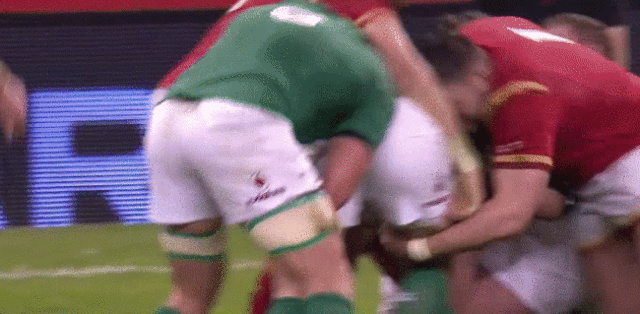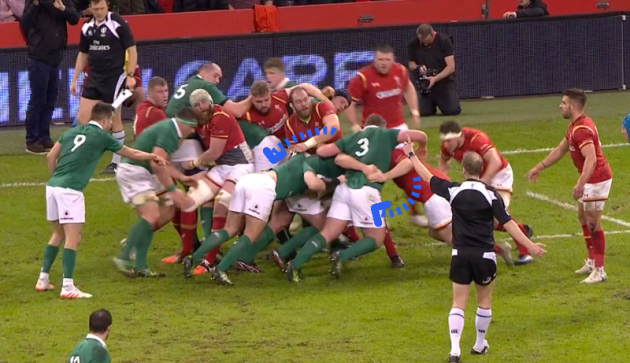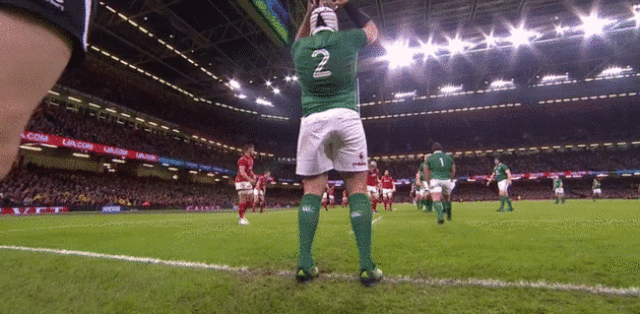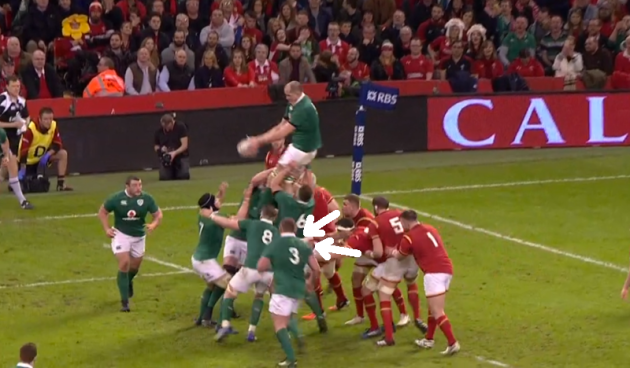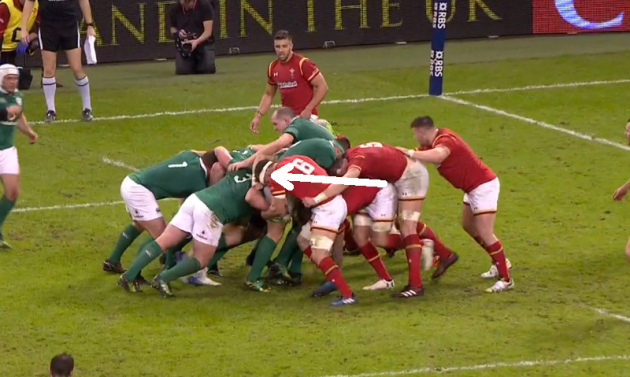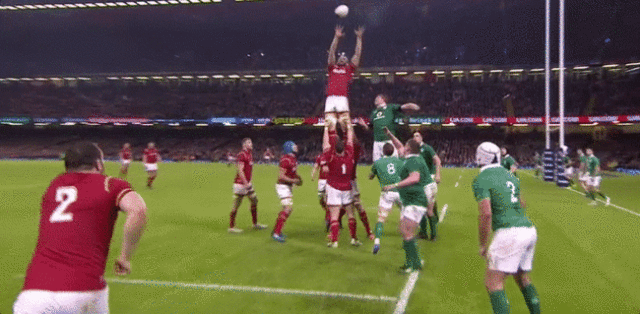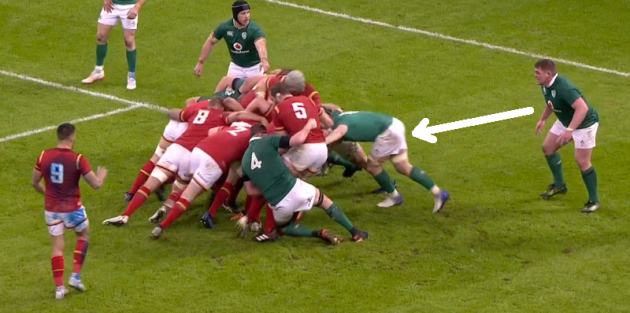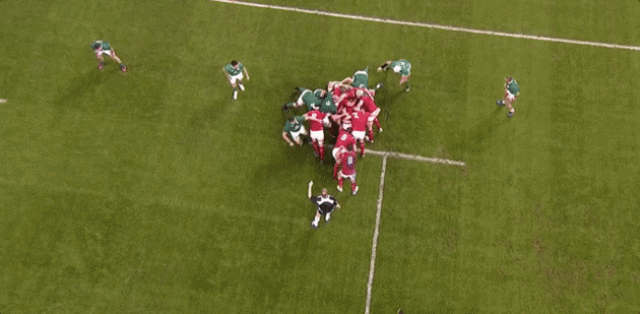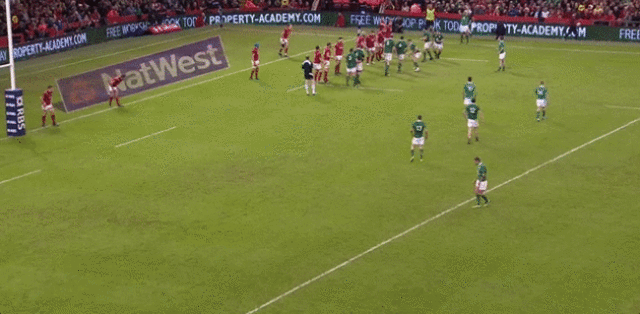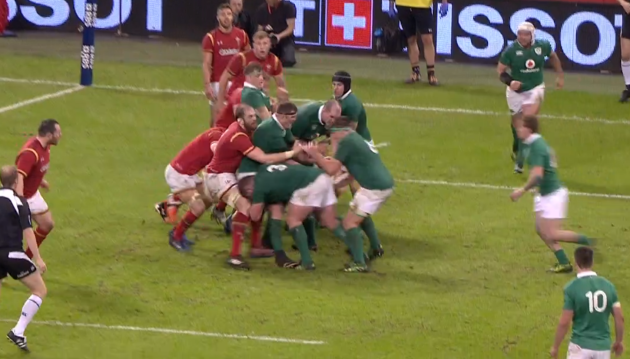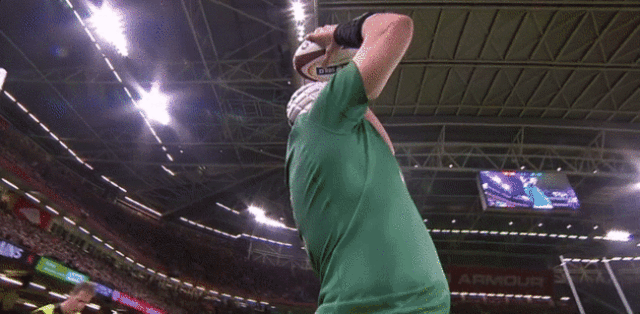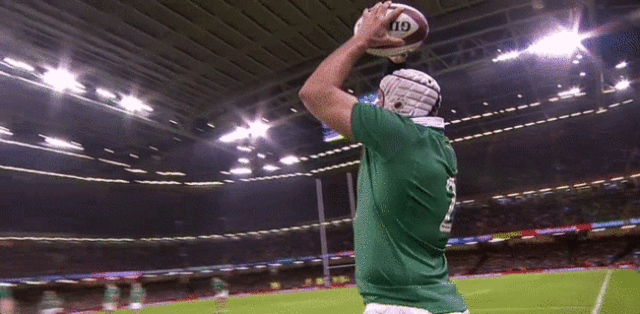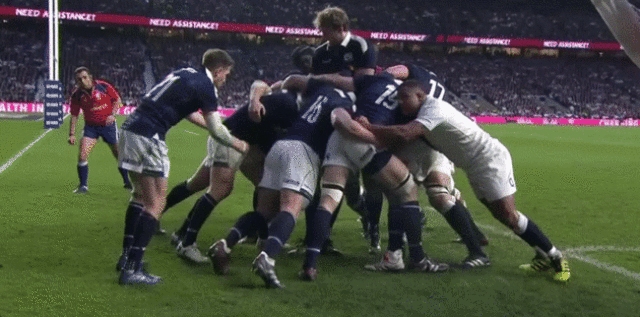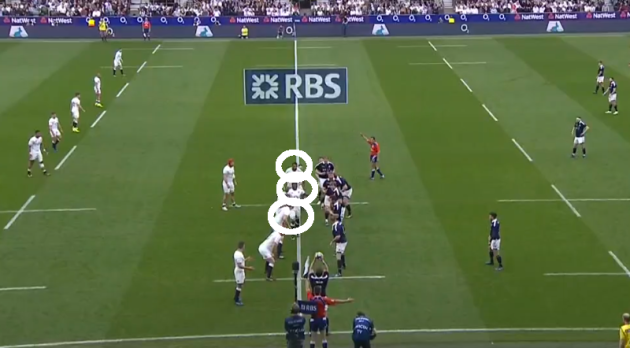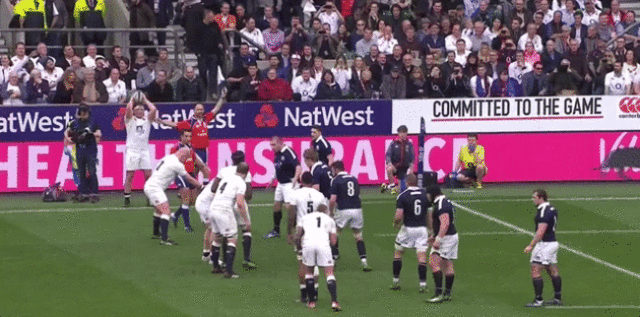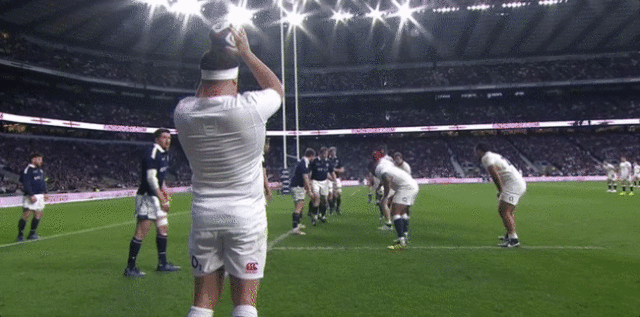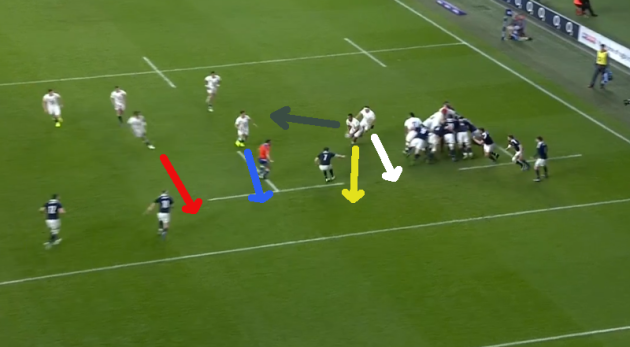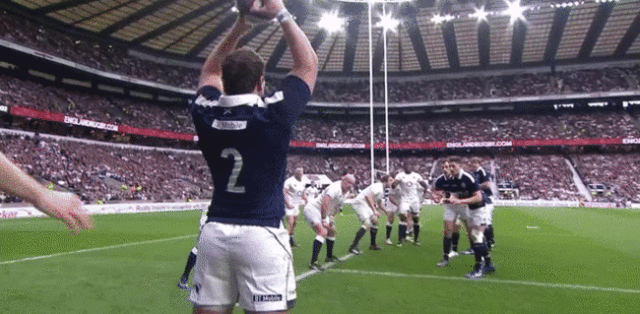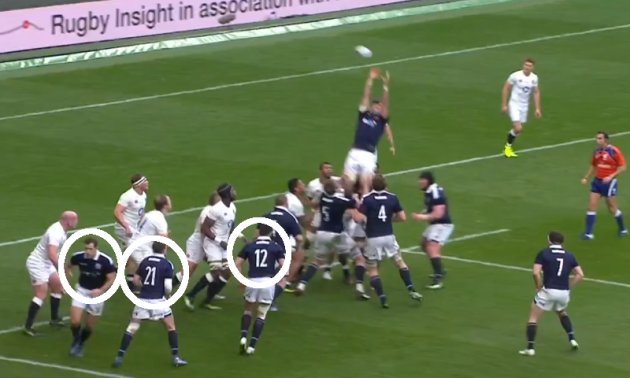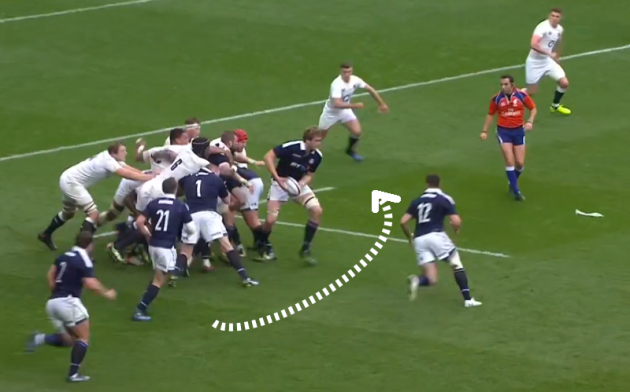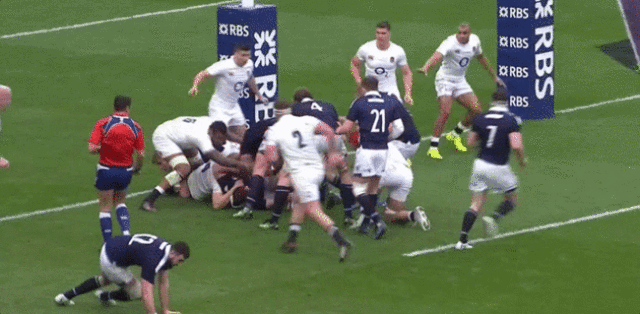Updated 16 March
THE ANALYSIS OF Ireland’s try-scoring trends we carried out before the Six Nations highlights exactly why their close-range failings against Wales were so costly.
Over the course of their 12 Test matches last year, 58% of Ireland’s tries came from lineout platforms. In other words, the passage of possession leading to the try began with an Irish throw into the lineout.
44% of Ireland’s tries came from possession platforms starting five metres out from the opposition line – predominantly lineouts but also five tries from five-metre scrums.
39% of Ireland’s tries involved mauls. Although they actually only scored directly with a maul once – Jordi Murphy’s try against the All Blacks in Chicago – they so often did the damage with that dangerous weapon before barging over.
Therefore, it goes without saying that an underperformance in these areas is almost certainly going to be hugely damaging for Ireland.
When they’re not converting their close-range chances, of which there are often very few in Test matches, Ireland are going to struggle to find tries, generally speaking.
Against Wales that was the case and the pressure is now massively on Ireland to deliver in this area as England come to Dublin on Saturday seeking a second consecutive Grand Slam.
The English, meanwhile, have been motoring along very nicely at lineout and maul time in this championship, losing possession just once on their own throw.
With Maro Itoje, Courtney Lawes and Joe Launchbury combining superbly in the set-piece, the English lineout is a major threat as Ireland look to ensure they don’t finish the 2017 Six Nations with just two wins.
Key moments
It’s easy to forget, but Ireland made a superb start to last Friday’s game in Cardiff, applying huge pressure to Wales and looking like the better team.
Already 3-0 ahead, they found themselves with a five-metre lineout in the 16th minute and, with it, a superb chance to deliver a dominant blow to the Welsh.
Below comes a huge moment in the game and, as with two superb early close-range chances in the defeat to Scotland, Ireland fail to convert.
The psychological importance of this Welsh steal was underlined by Paul O’Connell in BBC’s live commentary, and the former Ireland lock understands the importance of this mental side of the game better than most.
Wales, under intense pressure all week in the build-up, instantly grew in confidence, while Ireland deflated – possibly even having flashbacks to Murrayfield and the early failures to convert there.
As Joe Schmidt said afterwards in Cardiff, “When you don’t convert those, it’s very tough and it starts, for players, to feel pressure and players get a little bit tense and potentially don’t play with freedom.”
We know Ireland are reliant on Devin Toner in these instances as the lineout target, but they go for something slightly different here.
Sean O’Brien [7] starts in the ‘receiver’ position behind a six-man lineout – as we see above – and steps into the lineout to lift CJ Stander [6] at the front.
The receiver cannot make a move into the lineout until the ball has actually left the hooker’s hands on the throw, and O’Brien’s timing is fine in that regard, certainly in terms of how this law tends to be refereed.
O’Brien’s move forward into the lineout happens as Donnacha Ryan and Toner shift towards the front of the lineout as if Ireland are going to jump in that area.
They really need Wales to buy this dummy movement, but the home side don’t.
In fact, they clock Ireland’s intentions perfectly, with Alun Wyn Jones making a superb read to get up and win the ball.
In the clip above, we can see him intently watching O’Brien, then signalling to Sam Warburton in front of him to turn and lift.
Stander actually gets off the ground just before Jones, lifted by O’Brien at the front and Jamie Heaslip at the rear, but Jones is the better jumper and gets a strong hand to the ball to paw it back on Wales’ side.
Here we get a fine example of what a good defensive lineout jumper offers his team – an ability to read the play [based on extensive video analysis] and an explosive leap that is not always dependent on a perfect lift.
It’s brilliant defensive play from Jones and Wales, but Ireland will have questioned themselves in this instance.
Was this the correct call by lineout leader Toner? Toner himself is the most obvious target, of course, but perhaps he had the early instance against Scotland where Richie Gray picked him off in mind.
Ireland have an organised maul play in mind here – note how Jack McGrath goes from the front of the lineout into a position behind the jumping pod, with Tadhg Furlong doing the same from the rear – but with Jones marking up on the tail well, could they changed it, even at a late stage, to avoid that threat?
Of course, it’s very easy to comment on these things removed from the pressure and volume of a Six Nations game, but Simon Easterby and his pack will have spent time on this close-range failure in recent days.
Maul travails
The next time Ireland got to within sight of the Welsh line, they went back to basics, with Best speeding up his throw and finding Toner in the middle of a six-man lineout, with O’Brien as receiver to accept the transfer for a maul.
The maul makes good initial progress for Ireland this time and as they shear off to the right, still part of the maul, there is a threat to the Welsh tryline.
There are still over five metres for Ireland to make up, but the Welsh react swiftly to bring the maul to a halt.
Again, lock and captain Jones is central to the Welsh denying Ireland a sniff at the tryline, as he swims up the side of the maul and attacks the ball from an illegal position.
At the same time, hooker Ken Owens goes to his knees in front of the Irish maul, with the pair of Welsh defenders combining to bring it to ground.
While it’s against the laws of the game, this is good decision-making from the Welsh duo. They are doing their best to legally halt Ireland initially, but when that looks like it’s not going to work, they do what they have to to stop the promising maul.
One of the things we noticed in our analysis of Ireland’s tries last year was how often the opposition illegally stopped Irish mauls in situations like this.
Now, this is certainly not the reason Ireland lost against Wales – it was their own maul penalty against Robbie Henshaw later on that had a greater effect – but it’s understandable if there is some frustration there. One for Ireland to raise with the referees perhaps.
Whatever about that trend, Wales do enough and Ireland get a penalty, which is sent back into the corner.
This time, the Welsh defence is brilliant and legal.
Ireland go to Toner in the middle again, with O’Brien at receiver to help launch the maul, but Wales take advantage of a slight lack of accuracy in Ireland’s ‘bracing’ at the right-hand side of the maul.
Again, it’s ultra-intelligent defence, however.
As Toner begins to come back towards ground, note how Ross Moriarty and Warburton are focused on back lifter Stander, rather than Toner himself.
In many instances, the defensive team would be focused on ‘sacking’ the lineout jumper when he lands, i.e. tackling him instantly to the ground after he lands.
Here, Wales instead place their focus on the lifters, the men tasked with ‘bracing’ against the counter-drive of the Welsh.
If Stander at the back and Ryan at the front can brace against that impact and keep the Irish maul nice and tight, the power from behind will transfer into forward momentum.
But Warburton and Moriarty are able to split Stander away from the right-hand side of the Irish maul, as we see below.
With Ryan doing a good job of bracing on the other side, Ireland’s power is suddenly all on the left-hand side of the maul and it spins wildly around, Jake Ball happily pulling it as it goes.
That opens up the left side of the Irish maul for Rob Evans, Jones, Warburton and Owens to slam into the contest again.
Ireland are suddenly going backwards and they are forced to play the ball away through Stander, who breaks to the right, where Ireland are slightly fortunate to win a penalty as Wayne Barnes penalised the Welsh for not releasing after the tackle.
Johnny Sexton slots the three points, which is at least scoreboard damage, but Ireland will have been disappointed to be repelled.
Wales show how it’s done
When Wales got their five-metre chance early in the second half, they took it, albeit against 14 men with Sexton in the sin bin.
Even with that qualifier in place, this try gives us another example of how important the players in those bracing positions are.
Watch Rob Evans in the number 1 shirt for Wales below.
Evans lifts at the front and he’s in danger of being removed by the counter drive of Heaslip and Ryan.
But as Ryan focuses his attention on lineout catcher Jones, whose intention is to feed the maul moving away to his left – again note where Wales’ non-jumping and non-lifting forwards are waiting – Evans fights to stay in the maul.
He forces his way up inside Jones and Ryan, staying in the maul and ensuring that it’s balanced in terms of its power. Ball does a superb job in locking things up after lifting at the back of Jones, and the Welsh have a really tight, balanced drive up and running.
First, Furlong has to commit from the blindside channel.
And then, disastrously, Best has to do the same as the Welsh trundle towards the line.
Captain Best has initially been designated as the second defender in the blindside channel alongside Simon Zebo, but the maul threat is too great for him to resist.
Rhys Webb is keeping an intent eye on Best throughout, and as soon as the hooker puts his head down, the scrum-half breaks away and draws in the utterly exposed Zebo to feed George North for his second try.
Coming up short
We don’t need to go back over the maul opportunity that was spurned with Robbie Henshaw’s hugely frustrating penalty, but Ireland had other frustrations at maul and lineout time in this game.
In the 55th minute, Wales captain Jones was at it again with another superb intervention.
Ireland’s lineout play is clever here, with Toner moving towards the front and catching, before turning and handing the ball down to Ryan, around whom players are set to maul towards the Welsh line.
The execution from Ireland here is actually quite good, but unfortunately for them Jones makes a brilliant read and defensive action.
The temptation for him here is to put his head down and lump into what most presume will be a maul based around Toner landing, but Jones has done his homework and is ultra-alert.
He picks up the new ‘pod’ around Ryan in a split second and instead moves towards the Munster lock.
In the moment of time above, Jones simply has to pull off a swift tackle.
Ryan is in the process of transferring the ball to Stander and if Barnes sees a clear transfer before Jones has tackled Ryan, there’s a strong likelihood of a penalty. If Jones can’t tackle Ryan to the ground at all, Ireland are in a numbers-up mauling situation.
Jones’ dynamic tackle is superb, however, and he gets Ryan straight to ground, bringing the McGrath, Furlong and Stander with them.
Again, Ireland are forced to play away from the maul set-up and though they earn three points, it’s another try-scoring chance from close-range gone.
Finding Welsh hands
With Ireland increasingly dependent on Toner at the lineout – he took five of their 10 lineout wins overall – the threat of Jones getting up against him also increased.
In the 60th minute, Jones wins the ball against Toner.
The throw from Best is not ideal here. We can see that Toner is not near full stretch as he looks to claim the ball, removing some of the advantage his height offers at lineout time.
The lift on Jones is not even the strongest, but he can still get high enough to get a hand to the ball and knock it back on Wales’ side.
Just over two minutes later, immediately after Toner has been replaced by Iain Henderson, Ireland lose possession at the lineout again – they’re still chasing the game at 15-9, remember.
The camera angle is poor here, unfortunately, so we don’t get a full picture of what happens, but Luke Charteris – just off the bench – is able to win the ball simply by jumping himself, with virtually no lift.
It’s a very poor failure on Ireland’s part as they look for the kind of attacking platform they normally thrive playing off.
Easterby and his forwards will have to hope there are no repeats on Saturday in Dublin.
O’Mahony calls
The clamour for Peter O’Mahony to be called into Ireland’s starting XV this week has been widespread, although it would be difficult for Schmidt to drop one of his current back rows, even after the disappointment of Cardiff.
One of the things O’Mahony offers is brilliant lineout skill, both defensively and in attack.
Simply having him on the pitch would make life more difficult for the opposition defensive lineout, with his threat equal to those of Toner and Ryan – more strong options for the opposition to mark up on.
Above, we get a superb example of what O’Mahony can do on the opposition throw, as he pressures Tipuric into a poor delivery down to Gareth Davies, with the Welsh replacement scrum-half then tackled behind his own tryline for a five-metre Ireland scrum.
The explosive nature of O’Mahony’s jumping is obvious and even if Schmidt opts not to start the Munster captain this week, his lineout abilities could be important off the bench.
Longer-term, it would appear that getting O’Mahony’s lineout brilliance back into the team is a priority.
Tormentor in chief
While Ireland only had two frontline jumpers in Toner and Ryan throughout this championship – with Stander and the other back rows chipping in – England essentially have three locks in their team in Lawes, Launchbury and Itoje – who has been playing at blindside flanker, but sometimes scrummaging at lock.
Itoje is an utter nuisance on opposition lineout ball and has a team-leading three lineout steals for England in this Six Nations.
Ireland will know exactly what to expect, but we get an idea of Itoje’s annoyance factor in the example above.
The Saracens man, a brilliant player, shouts and shoves and does whatever he can to distract the opposition lineout. He has been known to actually call for the opposition hooker to throw to him. Donnacha O’Callaghan-esque.
Ireland will almost certainly bring any closing of the one-metre gap to referee Jerome Garces’ attention, but Itoje is about more than the nuisance.
His explosive leap off the ground is among the best in the world, meaning that when he gets a good read he can be very dangerous.
Itoje’s physical prowess and determination are also useful in defending mauls, as we see below.
Launchbury is equally important for England in this instance, with himself and Itoje finding a crack at the front of the Scotland maul and breaking through to force a scrum platform their side eventually scores from.
Options
Although Itoje is the primary competitor in the air for England on opposition ball, the presence of Launchbury and Lawes could be unsettling for Ireland too.
Though the locking pair haven’t stolen a ball in this championship, they have applied some good pressure.
The trio of English jumpers – they have back row options too, notably when Tom Wood is on the pitch – mean Ireland will be well marked in most areas and their decision-making and calling will have to be excellent.
Having three frontline jumpers is also important for England’s attacking game, and they are as reliant on the lineout platform as Ireland.
Above is the lineout that provides the platform for Anthony Watson’s brilliant first-phase try against Scotland and we can see how many strong options there are for the English.
Itoje, Launchbury and Lawes all have to be closely watched, while James Haskell at the front is another viable jumper.
Even with Scotland making a solid read and getting Ryan Wilson in the air, an excellent jump from Lawes is combined with an accurate throw from Dylan Hartley to allow England to play off the top with superb attacking ball.
The quality of England’s throw in this Six Nations has been excellent so far, both from Hartley and replacement Jamie George, as we see below.
Itoje takes the ball at the front here and, while he beats Jonny Gray off the ground, his life is made easier by the height of George’s throw, allowing him to claim at full stretch above Gray.
Much of England’s attack against Scotland was built on their lineout platform and we see one neat example here.
As soon as Billy Vunipola receives the transfer from Itoje and bounces out to his right, there are multiple options.
George has worked around to offer an inside pass option [white], Vunipola can carry in a one-on-one situation himself [yellow], Danny Care is offering the short passing option [blue], Ben Te’o is available on a skip pass [red], or Vunipola can even go out the back door [green].
Like most of what England did last weekend, the right option is taken and Care darts through for the try.
In simple terms, if England get clean, quick ball from their lineout again in Dublin, they will be extremely difficult to halt. Ireland must compete aggressively.
Conceding
England did concede a try to Scotland from a lineout last weekend and it might give us a glimpse into how Ireland are going to attack Eddie Jones’ side.
George Ford is the weakest defender in the England team – mainly because of his size, rather than a lack of bravery, technique or intent – and it would be a surprise if Ireland did not target him.
Scotland do so in this instance, and even though Ford makes a fine tackle, Scotland are launched into a short series of pick and jams that results in a try.
Ireland will recognise the lineout set-up from Scotland here, having conceded that embarrassing try in Murrayfield to it.
Above, we have circled the three Scottish backs who are part of the lineout – Tim Visser, Henry Pyrgos and Alex Dunbar.
This time, Dunbar is not the direct target of the lineout throw, but the variation is intended to send him running at the opposition tryline.
The inside centre loops around to the tail of the lineout and Richie Gray spins out of the dummy maul set-up to feed Dunbar for a one-on-one opportunity against Ford.
Ford does well to halt Dunbar, but a single phase later, Scotland’s clever lineout tactics pay off as England are short of forward defenders at the pillar of a ruck under the posts.
Scrum-half Ben Youngs is left in a position he doesn’t want to be in and Scotland prop Gordon Reid ploughs through him.
While Ireland certainly won’t use the exact same move as Scotland, it will be interesting to see how they target England in a similar manner.
Whatever about the method, Ireland simply must deliver a more efficient performance at lineout and maul time on their own throw on Saturday.
